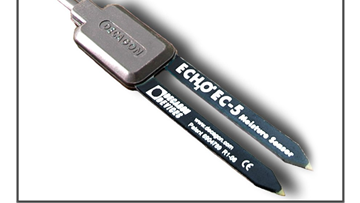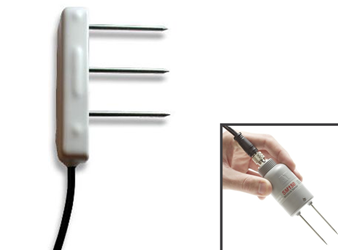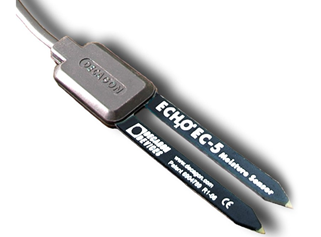Volumetric Water Content Sensors


Importance of Water in Plants
Most cultivated plants in the greenhouse and nursery industry contain more than 90% water. Water is vital for plants because it dissolves fertilizers and transports minerals through the plant, it maintains the plant cell turgidity, it is involved in the photosynthesis process (plants synthesize sugars from carbon dioxide and water), and it serves as a radiator to cool the leaves via the plant's stomata. The plant uses more than 90% of the water it absorbs to cool itself through transpiration while the remainder is used for chemical reactions. Proper watering is essential not just for transpiration and chemical reactions; it is also important because overwatering can cause root disease problems and a tremendous amount of water/fertilizer can be lost and contaminate rivers, lakes and the water table.
Importance of Proper Irrigation Management
Proper water scheduling and duration are not only essential for the production of good-quality crops; they can also save water, fertilizers and energy. In some cases, crops grow and develop faster than in improper watering conditions. Usually, the grower decides when to water based on experience, and considers the following elements: watering method, plant type, stage of the plant development, and environmental and substrate conditions. He also visually judges the plant. The negative side of this kind of water management is that watering could be excessive or insufficient, and in the worst-case scenario plants could suffer from water stress or die if watering events are too widespread during the week.
Volumetric Water Content Sensors
To overcome those hassles, volumetric water content (VWC) sensors can be used to determine when to water. The software for the output of the VWC sensors has evolved and it is possible to obtain the VWC 24/7 during the entire life of the crop. This data can be used for the watering schedule and duration. VWC sensors are inexpensive, low maintenance, ready to use (“plug and play”), and the data is easy to interpret. In advanced cases, the data can be obtained and the watering management can be done from anywhere in the world via the internet. The output can be shown as graphs or numerically. Depending on the type of sensor, the data can be collected every second and the average, recorded every 1, 5, 15 or 60 minutes. It is better to have a weather station at the growing facility to see how the amount of water applied, water taken by the plant, temperature, precipitation, solar radiation and relative humidity influence the VWC of the growing medium.
Water Content Sensors for Greenhouse and Nursery Production
The VWC is simply the ratio of the volume of water in the substrate divided by the total volume of the container. The VWC sensors are inserted into the growing medium and measure the VWC of the substrate contacting the sensors; the detection zone of the sensors is between 1 and 4 inches long (depending on the model and type of sensor). Two main types of sensors measure the volumetric water content in soilless media: Time Domain Reflectometry (TDR) and Capacitance. Both types of sensors measure the dielectric constant of the substrate. The dielectric constant is 1 for air, 3-5 for mineral soils, and 80 for water; thus, any change in those three parameters would change the dielectric constant of the substrate.
The TDR sensor consists of two or three parallel rods (probes), a pulse generator, a signal analyzer, and a cable attached to the datalogger. An electric pulse is applied to the rods, the pulse travels to the end of the rod and returns to the instrument. The time that the electric pulse takes to travel this distance will depend on the dielectric constant of the substrate. When the dielectric constant is high, the travel time of the pulse will be long, thus the substrate is wet.
- TDR Sensor Advantages: high accuracy and resolution, no need for calibration, the readings are not affected by the temperature or salinity of the substrate, and it lasts for several years.
- TDR Sensor Disadvantages: high cost and limited detection zone (1 inch).

The Capacitance sensor consists of a pair of rods (capacitors) separated by a material that does not conduct electricity or a dielectric material (for this case substrate), an oscillator, a signal analyzer, and a cable attached to the datalogger. The oscillator applies a frequency to the rods; the VWC of the substrate will influence the dielectric constant of the soil affecting the capacitance. Finally, the magnitude of the frequency obtained by the oscillator is then correlated to the VWC of the soil. The higher the magnitude of the frequency is, the lower the VWC.
- Capacitance Sensor Advantages: it is very sensitive to small changes in moisture, has good resolution and a larger detection zone compared with TDR.
- Capacitance Sensor Disadvantages: needs calibration and low life expectancy.

Rod Orientation in the Substrate
There are two ways to install these sensors: vertical or horizontal. When the sensor is inserted into the substrate vertically, it averages the VWC of the substrate from the top to the bottom of the sensor. As seen in previous newsletters, the water content of the substrate depends highly on the particle size and the height of the container. If the pot is tall and contains a coarse substrate, the water content is going to change dramatically from the top to the bottom of the pot.
When the sensor is placed horizontally, the SWC will be measured just for the height where the rods are positioned. In other words, if the sensor is placed at 4 inches from the bottom of the pot, it is going to give the VWC of the substrate at a height between 2 and 6 inches (depending on the size of the detection area on the sensor). Another issue with placing the sensors horizontally is that they are going to be affected by the downward water movement. If the rods are flat, it is recommended to place the flat part perpendicularly to the base of the pot; this is because water could stand on the surface of the flat rods, producing unreliable measurements.
Both types of sensors require the rods to have intimate contact with the substrate, so there should be no air gaps or large substrate particles around the sensor, and the sensor rods must be completely buried in the substrate to produce accurate readings.
When choosing a sensor, it is important to know if the sensor is calibrated for soilless media, if it is going to work for your substrate (particle size, and maximum and minimum water content), and if it is accurate enough for your watering strategies. Other important points to consider are the capabilities of the sensor, maintenance, plant water requirements at different stages, the substrate's physical characteristics, and how to interpret the data.